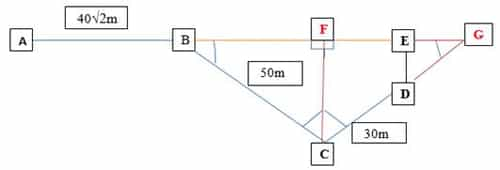Understand the basics of Direction Sense & Distance
You must be well aware that Distance & Direction is the part of the Reasoning Section of any banking exam and truly saying, this is one of the easiest topics out of all. So to make sure that you don't miss out any question from this topic in Exam, we are going to discuss the basics of distance & direction in this article.
As the name of the topic clearly explains that we deal with finding distance or direction in the questions of this topic. But for dealing with the questions from this topic, we must have a very clear idea about two things.
- Basic Directions
- Pythagoras theorem
1. Basic Directions: We have 8 basic directions which should be crystal clear to us for attempting distance and direction questions.
One key point that should be kept in mind is that If not mentioned we always assume that the person is facing north.
2. Pythagoras theorem: According to this theorem,” The square of Hypotenuse is always equal to the sum of the squares of the other two sides of the right angle triangle”.
Suppose we have a triangle having base p, height q and hypotenuse r. Then according to this theorem:
p2+q2=r2
Now you have the basics required to atttempt Distance & Direction questions. So let us try to look at few questions on the same so that you will get to know the proper approach to solve these questions.
Some other basics:
1.B is to the east of A.
2. B is to the west of A.
3. B is to the north of A.
4. B is to the south of A.
5. B is to the North East of A.
6. B is to the North West of A.
7. B is to the South East of A.

8. B is to the South West of A.
Direction: Ashok started walking towards South. After walking 50 meters he took a right turn and walked 30 meters. He then took a right turn and walked 100 meters. He then took a left turn and walked 30 meters and stopped. How far and in which direction was he from the starting point?
Solution:
Ashok started walking towards south.
After walking 50 meters...
..he took a right turn…
Some people have doubt in deciding left or right in direction questions; they can replace right by clockwise and left by anticlockwise. So now moving right (clockwise) from the tip of the arrow.
…and walked 30 meters.
He took a right turn…
…and walked 100 meters.
He took a left turn…
…and walked 30 meters.

Now for finding how far he has moved, we will check two things:
- Horizontal displacement
- Vertical displacement
Horizontal displacement = 30+30 = 60m
Vertical displacement = 100-50 = 50m
Final displacement = √(602+502) = √(3600+2500) = √6100 = 10√61 m
Now for finding the direction with reference to initial position, we will draw a line joining two points which will give us the direction.

We can clearly see that the direction in which Ashok moved is northwest.
So the final answer for this question will be “Ashok moved 10√61 meters in northwest direction”.
Directions: Jay starts his van from point X and covers a distance of 10 km towards west, then he turns north and covers a distance of 7 km. Again, he takes a right turn and covers 25 km. Now he covers 6 km, after taking a left turn. At last he takes a left turn and covers 15 km and stops at point Z.
Solution:
Jay starts his van from point X and covers a distance of 10 km towards west
then he turns north
and covers a distance of 7 km
Again, he takes a right turn
…and covers 25 km
Now he covers 6 km, after taking a left turn.
At last he takes a left turn…
…and covers 15 km and stops at point Z.
Q. Towards which direction was the van running before stopping at point Z?
- North
- East
- West
- South
- None of these
Solution: We can clearly see that van was running towards west before stopping at point Z.
So the correct answer is C.
Q. How far is Jay from point X?
- 23 km
- 25 km
- 17 km
- 50 km
- None of these
Soution:
Horizontal movement = 10-25+15 = 0 kms
Vertical movement = 7+6 = 13 km
So final movement = = √(02+132) = √169 = 13 km
Direction of movement is North.

For BE and ED:-
In triangle BCG, Angle C is 90 degree, angle B and G are of 45 degrees, and total length of line CG must be 50m (symmetry).
BG ² = BC2 + CG2 (PT theorem)
BG2 = 502 + 502 = 2*502
BG = 50 √2
Length of DG = CG – CD = 50 – 30 = 20m.
In triangle DEG
DE/DG = Sin45
DE/20 = 1/ √2, DE = 20/ √2 = 10√2
EG/DG = Cos45
EG/20 = 1/√2, EG = 20/√2 = 10√2
The length BE = BG – EG = 50√2 - 10√2 = 40√2
Total Distance covered by him = AB + BE + ED = 40 √2 + 40 √2 + 10 √2 = 90 √2
Shadow Based Concepts of Direction Sense
In Morning (During Sunrise)
The sun rises in East direction. At the time of the sunrise/ morning, if a man is standing, the shadow of a man always falls on West.
In Evening (During Sunset )
The sun rises in West direction. At the time of the sunset/ evening, if a man is standing, the shadow of a man always falls on East.
At 12'o clock
There is no shadow at this time. At this time, the sun is exactly above our head, so no shadow is formed at 12'o clock.
Key points related to Distance & Direction:
- Always remember the basic directions.
- Pythagoras theorem is valid only for a right angle triangle.
- The direction of right turn is always in the clockwise direction.
- The direction of left turn is always in an anti-clockwise direction.
- The direction of North is to the upwards side.
- The Direction of East is to the right.
- The direction of West is to left.
- Always approach the question step by step.
- In the End, join the initial and final point to get to know the distance and relative direction.
- If in any of the questions, the relative direction is given. i.e. P is to the north of Q, then you can use the basic directions to get the location of P and Q


































![How to Use of Has/Have [Basic points Rules Structures Examples]](https://blogger.googleusercontent.com/img/b/R29vZ2xl/AVvXsEhFSWAQkVMciY5IncRVU8ma_BY7G9IKy1LtzgBouDX_zHPxZ3D85UUXcizg9w-0Xhe13T2TbkJAPP1j4JMfeF-vTn1EHo_HvQp2UmlyUkGduqNjvCWIQwOTl0u4AN5SHMBol-18xO-7mYA/w72-h72-p-k-no-nu/Slide8.PNG)











0 Comments